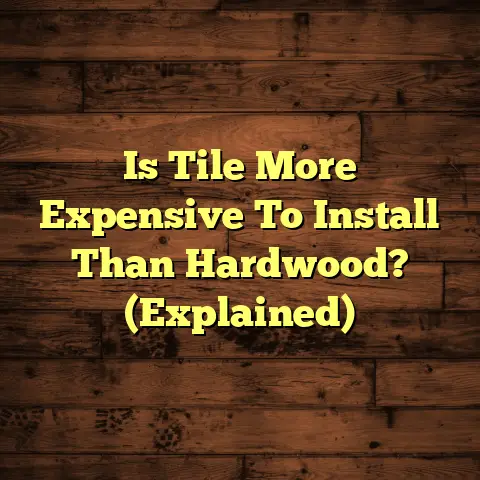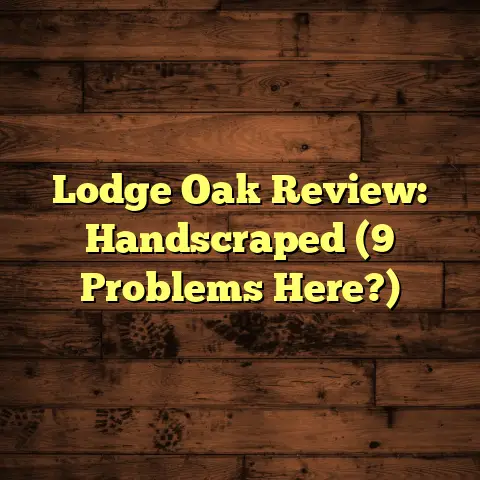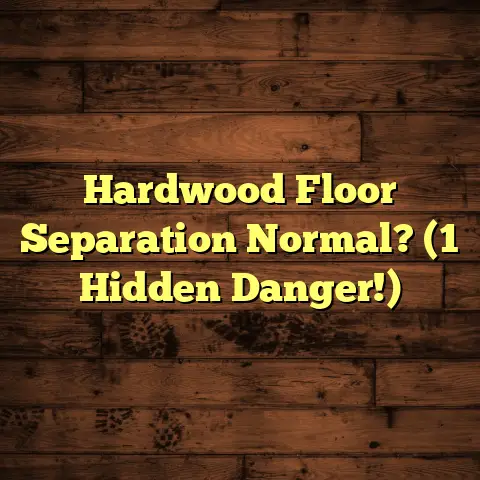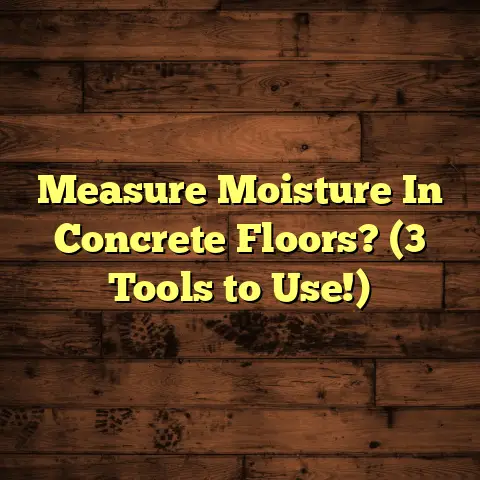Hardwood Cost: Evaluate Now! (4 Wood Choices!)
There’s just something about a hardwood floor, isn’t there?
The click-clack of your shoes, the smooth, solid feel underfoot… it’s a total vibe.
The natural warmth, the way it just elevates a room… it’s hard to beat.
I’ve been a flooring contractor for over 15 years, and I can tell you, nothing quite matches the feeling of walking into a home with beautifully installed hardwood.
It’s not just about the looks. It’s about the feeling.
That subtle give underfoot that tile just doesn’t have, the way it warms up a room that carpet can sometimes make feel stuffy.
It’s that sense of home. That’s what hardwood brings.
But let’s be real. That feeling comes at a price.
And choosing the right hardwood? That’s a whole other ballgame.
That’s why we’re diving deep into the world of hardwood costs today.
We’ll break down everything you need to know to make an informed decision, so you can get that amazing feeling without breaking the bank.
Ready? Let’s get started!
Understanding Hardwood Flooring
So, what is hardwood flooring anyway?
Simply put, it’s flooring made from a single piece of wood.
Unlike laminate or vinyl, which are essentially printed images on a synthetic core, hardwood is the real deal.
Think of it as the OG of flooring.
Hardwood has been around for centuries.
From the grand estates of Europe to cozy farmhouses in America, it’s been a staple for its durability and beauty.
Over time, the methods have evolved, but the core appeal remains the same: natural beauty and lasting quality.
Now, when we talk about hardwood, there are two main types:
- Solid Hardwood: This is exactly what it sounds like: a solid piece of wood, typically ¾ inch thick.
- Engineered Hardwood: This consists of a thin layer of hardwood veneer glued to a plywood or fiberboard core.
Solid Hardwood: It can be sanded and refinished multiple times, making it incredibly long-lasting. However, it’s more susceptible to moisture damage and can expand and contract with changes in humidity.
Engineered Hardwood: It’s more stable than solid hardwood, making it a better choice for basements or areas with high humidity. While it can be sanded and refinished, the number of times depends on the thickness of the veneer layer.
The type of wood species you choose also plays a huge role in the overall look, feel, and cost of your floor.
Think of it like choosing the ingredients for a gourmet meal.
Each species has its own unique characteristics, from the grain pattern to the hardness, which ultimately affects the final product.
We’ll get into the specifics of different wood choices shortly, but for now, just remember that understanding the basics of hardwood is crucial before diving into the cost.
Evaluating Hardwood Cost
Alright, let’s talk money!
The cost of hardwood flooring can vary wildly, depending on several factors.
Understanding these factors is key to staying within your budget.
Here’s a breakdown:
- Wood Species: This is the biggest cost driver. Rarer and more desirable species like walnut or cherry will naturally cost more than common options like oak.
- Quality and Grade: Hardwood is graded based on appearance, the number of knots, and other imperfections. Higher grades with fewer imperfections will be more expensive.
- Finish Options: Pre-finished hardwood comes with a factory-applied finish, which can save you time and money on installation. Unfinished hardwood allows you to customize the stain and finish, but adds to the overall cost.
- Installation Costs: This can be a significant expense, especially if you’re not a DIYer. Professional installation can range from \$3 to \$8 per square foot, depending on the complexity of the job.
Let’s dive a little deeper into each of these:
Wood Species: Think of oak as the reliable, everyday choice. Walnut is like the luxury sports car. Oak is abundant, while walnut is more scarce, hence the price difference.
Quality and Grade: You’ll often see terms like “select,” “common,” and “rustic” used to describe hardwood grades. Select grade has the fewest imperfections, while rustic grade has more knots and character.
Finish Options: Pre-finished floors are convenient. Unfinished floors are for those who want complete control over the final look.
Installation Costs: While DIY installation can save you money, it’s not for the faint of heart. If you’re not experienced, you could end up with a poorly installed floor that costs you more in the long run to fix.
So, what can you expect to pay?
Here’s a general overview of price ranges:
| Wood Species | Price Range (per sq ft) |
|---|---|
| Oak | \$3 – \$8 |
| Maple | \$4 – \$9 |
| Cherry | \$6 – \$12 |
| Walnut | \$8 – \$15 |
Note: These are just estimates. Prices can vary depending on your location and the specific supplier.
Remember, this is just the cost of the materials.
You’ll also need to factor in underlayment, adhesives, and the cost of labor if you’re hiring a professional installer.
In-Depth Analysis of Four Wood Choices
Okay, now for the fun part! Let’s take a closer look at four popular hardwood choices: oak, maple, cherry, and walnut.
Choice 1: Oak
Oak is a classic for a reason. It’s durable, readily available, and has a beautiful grain pattern that can complement a variety of styles.
As a contractor, I’ve installed more oak floors than I can count. It’s a workhorse that holds up well to everyday wear and tear.
Characteristics: Oak is known for its prominent grain pattern and warm color tones. It’s a relatively hard wood, making it resistant to dents and scratches.
Durability: On the Janka hardness scale (a measure of a wood’s resistance to denting), oak typically ranges from 1290 (red oak) to 1360 (white oak). That makes it a solid choice for high-traffic areas.
Aesthetic Appeal: Oak’s grain pattern can range from subtle to bold, depending on the cut of the wood. It can be stained in a variety of colors, from light and airy to dark and dramatic.
Cost Analysis: Oak is one of the more affordable hardwood options. You can typically find it for \$3 to \$8 per square foot, depending on the grade and finish. Installation costs are also relatively standard, ranging from \$3 to \$6 per square foot.
Popularity and Common Uses: Oak is a popular choice for living rooms, bedrooms, and hallways. It’s also commonly used in kitchens, although you’ll want to be careful about spills and moisture.
Choice 2: Maple
Maple is another popular hardwood choice, known for its smooth grain and light color. It offers a more contemporary look compared to oak.
I often recommend maple to clients who want a clean, modern aesthetic.
Characteristics: Maple has a fine, uniform grain pattern and a creamy white to light brown color. It’s a very hard wood, making it even more resistant to dents and scratches than oak.
Durability: Maple typically scores around 1450 on the Janka hardness scale. That makes it an excellent choice for homes with kids and pets.
Aesthetic Appeal: Maple’s light color and subtle grain pattern make it a versatile choice that can work well with a variety of design styles. It can be stained, but it’s often left natural to showcase its inherent beauty.
Cost Analysis: Maple is slightly more expensive than oak, typically ranging from \$4 to \$9 per square foot. Installation costs are similar to oak.
Suitability for Different Environments and Design Styles: Maple is a great choice for modern, minimalist, and Scandinavian-inspired spaces. Its light color can help brighten up a room, and its smooth grain pattern adds a touch of elegance.
Choice 3: Cherry
Cherry hardwood is prized for its rich color and elegant grain pattern. It adds a touch of warmth and sophistication to any room.
I’ve seen cherry floors transform ordinary spaces into luxurious retreats.
Characteristics: Cherry has a distinctive reddish-brown color that deepens over time as it’s exposed to light. It has a smooth, closed grain pattern and a natural luster.
Durability: Cherry is softer than oak and maple, with a Janka hardness rating of around 950. While it’s still a durable wood, it’s more susceptible to dents and scratches.
Aesthetic Appeal: Cherry’s rich color and elegant grain pattern make it a popular choice for formal living rooms, dining rooms, and bedrooms. It’s often used in high-end homes and custom architectural designs.
Cost Analysis: Cherry is more expensive than oak and maple, typically ranging from \$6 to \$12 per square foot. Installation costs are similar to other hardwoods.
Desirability in High-End Markets and Use in Specific Architectural Designs: Cherry is often used in traditional and transitional designs. Its warm color and elegant grain pattern add a touch of luxury and sophistication.
Choice 4: Walnut
Walnut is the king of hardwood. It’s known for its luxurious appeal, unique grain patterns, and rich, dark color.
I’ve installed walnut floors in some truly stunning homes. It’s a statement piece that elevates the entire space.
Characteristics: Walnut has a deep, chocolate-brown color and a distinctive grain pattern that can range from straight to curly. It’s a relatively soft hardwood, but it’s still durable enough for residential use.
Durability: Walnut has a Janka hardness rating of around 1010. While it’s not as hard as oak or maple, it’s still a durable wood that can withstand everyday wear and tear.
Aesthetic Appeal: Walnut’s rich color and unique grain patterns make it a popular choice for high-end homes and luxury spaces. It’s often used in living rooms, dining rooms, and home offices.
Cost Analysis: Walnut is the most expensive of the four wood choices, typically ranging from \$8 to \$15 per square foot. Installation costs can also be higher, due to the care required to handle this premium material.
Types of Homes Where Walnut Flooring Is a Preferred Choice: Walnut flooring is often found in modern, contemporary, and traditional homes. Its rich color and unique grain pattern add a touch of sophistication and elegance.
Conclusion
Choosing the right hardwood floor is a big decision.
It’s an investment that will affect the look, feel, and value of your home for years to come.
I hope this article has given you a better understanding of the factors that influence the cost of hardwood flooring and the unique characteristics of different wood choices.
Remember, it’s not just about the price tag.
It’s about finding a floor that fits your personal style, your budget, and your comfort needs.
Think about how the floor will feel underfoot, how it will look with your furniture, and how it will hold up to your lifestyle.
Don’t be afraid to ask questions, do your research, and get samples before making a final decision.
And most importantly, trust your gut.
Choose a floor that you love, that makes you feel good, and that you’ll be happy to live with for years to come.
Happy flooring!





